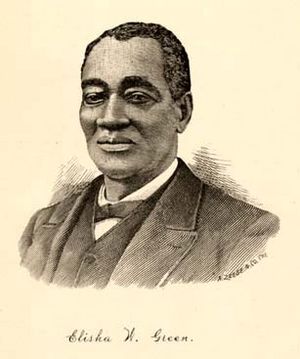Elisha Winfield Green facts for kids
Quick facts for kids
Elisha Winfield Green
|
|
|---|---|

Elisha Winfield Green, from the frontispiece of his 1888 autobiography
|
|
| Born | c. 1815 Bourbon County, Kentucky |
| Died | 1893 |
| Occupation | Baptist leader |
| Language | English |
| Nationality | American |
Elisha Winfield Green (around 1815—1893) was an important Baptist leader in Kentucky, US. He was born into slavery but later gained his freedom. For five years, he led the Consolidated Baptist Educational Association. He also helped start what is now the Simmons College of Kentucky, a school for African Americans. Elisha Green faced unfair treatment and racism throughout his life. Even as an older, respected minister, he was attacked on a train for not giving up his seat.
Contents
Early Life
Elisha Green was born in Bourbon County, Kentucky. When he was about ten years old, he was taken away from his mother. He became a slave for the Dobbyns family in Mason County, Kentucky.
In 1835, Elisha married Susan Young. Three years later, in 1838, his wife was sold to another person. She was then sold again to a slave trader. Luckily, Elisha's owner bought Susan back, and they were reunited. However, his owner later had money problems and had to sell both Elisha and Susan. In 1845, he managed to buy them back once more.
A Leader in the Baptist Church
In the early 1840s, Elisha Green started working as a sexton (a church caretaker) at a white Baptist church. He began to attend church services regularly with the white members. Some of the church leaders saw how promising he was. They asked his owner for permission to let him become a preacher.
On May 10, 1845, Elisha Green was given a special license to preach. He began preaching at the First African Baptist Church in Paris, Kentucky. Later, he also became a pastor in Maysville, Kentucky. This allowed him to travel freely between the two towns.
Gaining Freedom
In November 1848, a group of white men from the Baptist church in Mason County helped Elisha. They loaned him $850 so he could buy his and his family's freedom from the Dobbyns family. Elisha was able to pay back this loan using the money he earned as a preacher.
After becoming free, Elisha Green started a whitewashing business to support his family. He also worked other jobs, like fixing chairs, repairing shoes, and carpentry. At the same time, he worked with other African American Baptist leaders, such as George Washington Dupee. Together, they worked to organize and grow the church.
Building Communities and Schools
Elisha Green believed that formerly enslaved people needed to own their own land. He and a white landowner started an African American community near Paris, Kentucky.
After the American Civil War ended in 1865, Elisha Green became involved in politics. In 1867, he was chosen as the vice president of the Kentucky Negro Republican Party. This happened at their meeting in Lexington.
Soon after the State Convention of Colored Baptists in Kentucky was formed in 1865, Green suggested they create a school. This school was first called the Kentucky Normal and Theological Institute. Today, it is known as the Simmons College of Kentucky. Elisha Green also led the Mount Zion Baptist Association for eleven years. For five years, he was the leader of the Consolidated Baptist Educational Association.
Facing Racism
Elisha Green experienced unfair treatment and racism throughout his life. After he bought his freedom, people often stopped him while he was traveling between his churches. They would ask whose slave he was. If he said he was free, it would make people suspicious. So, he would simply answer, "Mr. Green."
In the mid-1850s, Elisha Green was traveling with his wife to Paris. He saw his son, John, with his hands tied. John was being taken away to be sold "down the river," meaning to the deep South. Elisha tried desperately to convince the owner to sell his son locally instead. But he could not protect his son.
In 1855, while he was preaching at George Dupee's church in Georgetown, a white man came into the church carrying a stick. The man asked if there was a white person present. When he was told there wasn't, he demanded that Green leave the pulpit.
The Train Incident
In 1883, Elisha Green was an elderly and respected church leader. He was traveling by train between Paris and Mayfield. A white minister, who was the head of a girls' school, got on the train with his students and staff. He rudely demanded that Green give up his seat. When Green refused, he was attacked and beaten. He suffered injuries to his head and hand.
Green decided to sue the person who attacked him. He won $24 in damages for the assault. However, reports of this incident and its outcome did not stop the unfair treatment of African Americans. Instead, it showed the growing movement among white people to separate people by race.

